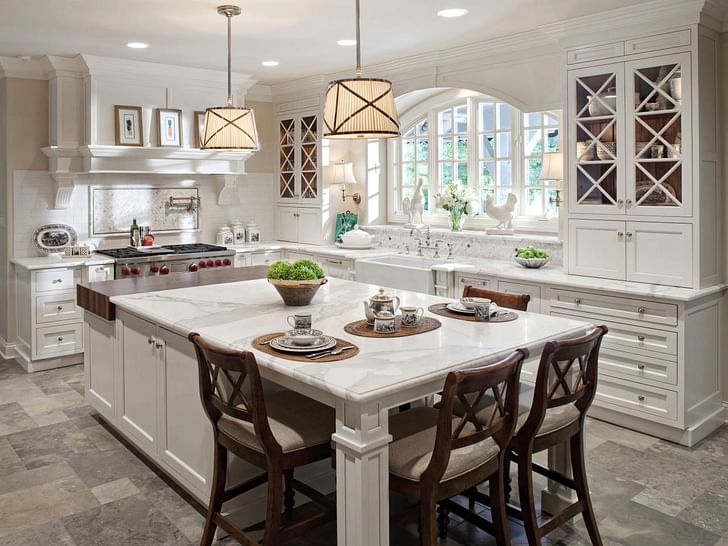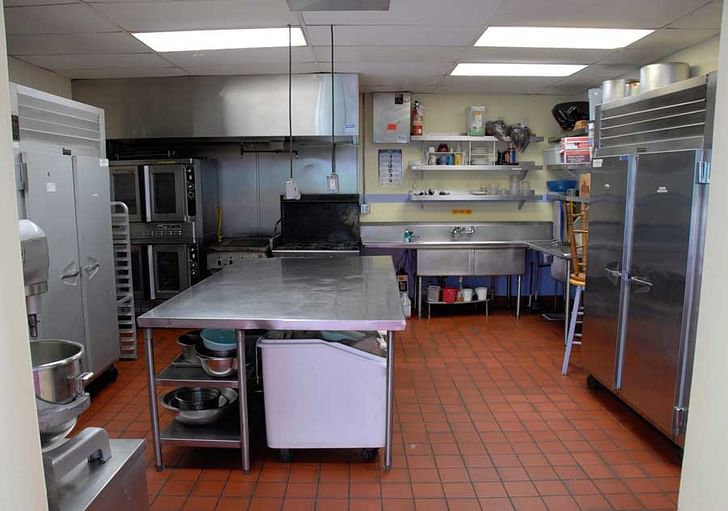

Kitchen design in the U.S. has evolved substantially in the last 100 years, moving from a service-oriented back room to the third largest space in houses. This shift has played a role in how people define domesticity, domestic relationships, and even community at large.
In the Western world a century ago, the kitchen had all the glamour of a contemporary laundry room. As a service space, the kitchen was certainly not designed to be a social nexus, a duty which largely fell to the parlor or living room. In a highly gendered and class-conscious society, the kitchen was a place for women and, in wealthy homes, servants: it wasn’t until Frank Lloyd Wright’s then-revolutionary open plan home designs that the kitchen began to emerge from the back-room into the center of domestic life.

But then television happened, and with it a dramatic shift not only in how meals were consumed, but the way in which their preparation was conceived. Some credit television personalities like Julia Child,a layout designed to accommodate both work and leisure activities began to demand more from architects. who flambe’d from a relatively ordinary middle-class kitchen TV-set, with transforming the kitchen from pure service-oriented design into a glamorous, even desirable, space. The idea of accessorizing one’s kitchen and making it into a focal gathering space started becoming a mainstream preoccupation. Electrical appliances, which had first started to enter the kitchen in the early 1900s, rapidly developed beyond cooking-only functions: a kitchen TV, perhaps located next to the built-in microwave, was not uncommon. As more varied activities began to take place in the kitchen, the complexity of the appliances involved and a layout designed to accommodate both work and leisure activities began to demand more from architects. The kitchen had come into its own, becoming one if not the primary domestic centers of the nuclear family.
Specifically, the kitchen island became a bridge between the dining room and the preparatory space: meals could now be consumed on the island or standing up, idly watching the kitchen TV. In fact, the kitchen island functions as the aortic valve of contemporary domesticity’s heart. As designer Debra Tendler of Kitchen Works LA/Leicht told me about recent design trends in her business, “The bigger the island, the better. Mainly the cooktop is in the island, and the seating is on the one side, or on one side and around a little bit.” She notes that many of these islands are designed to seat between four and six people. “That is the main design of the kitchens that we’re doing right now, and that’s 95% of them.”

Despite the fact that the nuclear family is quickly becoming a relic, the kitchen has retained its role as the domestic center of many living situations: in co-living arrangements, micro-apartments, and many community-oriented workspaces, the kitchen is where people gather to connect. Co-living spaces like WeLive and OpenDoor purposefully design their facilities and group activities around the kitchen, while micro-apartment buildings frequently have communal kitchens to maximize individual unit space and foster community bonding. In architectural offices, the kitchen is often where notices are pinned, morale-boosting delicacies deposited, and deadline-addled co-workers comforted.

The domestic nature of the kitchen became especially pronounced to me while on-assignment for Archinect’s April issue on Sex, during a tour of San Francisco’s The Armory—a former National Guard arsenal that has been converted into a porn production studio. all the fleshy rigor going on downstairs was complemented by the relative serenity of the kitchen.The jaded demeanor of my tour guide Dusty, who led me through rooms full of whips, chains, automated dildos and oil paintings of transgender fellatio, softened only when she lead me into the facility’s newly refurbished kitchen. “This is our kitchen,” she said with pride and a slight amount of awe, gesturing to a large natural-light infused space with a rack of hanging copper pans over a multiple-burner stove. A small cluster of models, taking a break from a shoot, ate sandwiches casually together in front of the refrigerator. It was downright homey; all the fleshy rigor going on downstairs was complemented by the relative serenity of the kitchen. “A chef comes and prepares meals for us,” Dusty explained sweetly, noting that “us” can consist of up to 150 staff and visiting models daily. It’s the one of the few places in The Armory where everyone can relax and be themselves, and as such, functions as the organization’s de facto center.

The kitchen has certainly not lost its central role in the domestic sphere for single family homeowners either: in July 2016, a poll conducted by website Houzz of 120,000 homeowners revealed that the kitchen is one of the most frequently remodeled rooms in the house. While communal living The kitchens are getting bigger and the other rooms are getting smaller, for sure.seems to embrace the kitchen as a gathering point, wealthy homeowners are increasingly asking for two kitchens: a so-called “social kitchen” and a “chef’s kitchen.” The social kitchen is, as you’d expect from the description, also a place for eating, lounging, drinking, and chatting with others, while the closed or chef’s kitchen is a return to the efficient functionality of the century-old model. Closed kitchens can be visually separated from the remainder of the apartment with pocket doors, and according to an article in the New York Times, provide both more privacy for homeowners and more design options for architects.
So what other design innovations/changes are in store for the kitchen? On a superficial level, Debra Tendler told me that wine coolers are in; steam ovens and microwaves are out. Handle-less systems are popular, while all-white kitchens have lost favor to wood finishes and glass. When I asked her if she thinks that kitchens are increasingly becoming the center of where people live in their homes, she said, “Absolutely, yeah. The kitchens are getting bigger and the other rooms are getting smaller, for sure.”
This piece is part of our special editorial theme for July 2016, Domesticity. Check out related content here.
Julia Ingalls is primarily an essayist. Her work has appeared or is forthcoming in Slate, Salon, Dwell, Guernica, The LA Weekly, The Nervous Breakdown, Forth, Trop, and 89.9 KCRW. She's into it.
No Comments
Block this user
Are you sure you want to block this user and hide all related comments throughout the site?
Archinect
This is your first comment on Archinect. Your comment will be visible once approved.